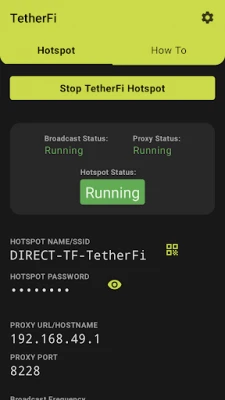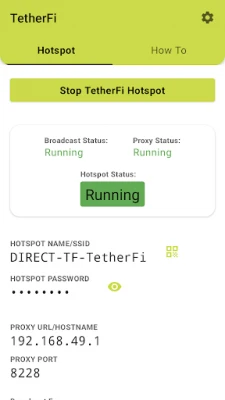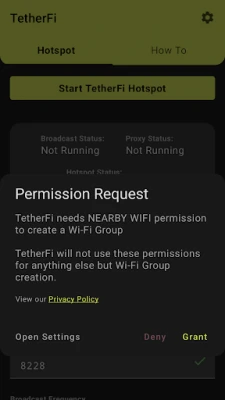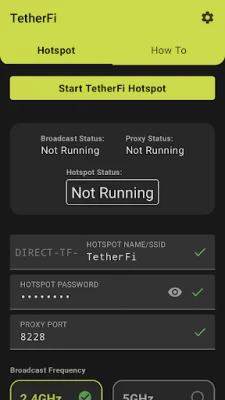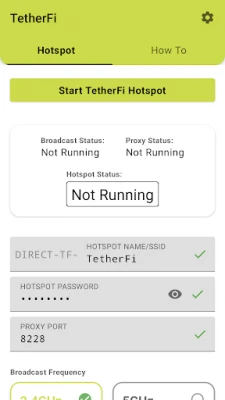
Latest Version
Version
20240114-1
20240114-1
Update
February 18, 2024
February 18, 2024
Developer
pyamsoft apps
pyamsoft apps
Categories
Tools
Tools
Platforms
Android
Android
Downloads
35
35
License
Free
Free
Package Name
com.pyamsoft.tetherfi
com.pyamsoft.tetherfi
Report
Report a Problem
Report a Problem
More About TetherFi
• What
Share your Android device's Internet connection with other devices without needing Root.
TetherFi works by creating a Wi-Fi Direct legacy group and an HTTP proxy server. Other devices can connect to the broadcasted Wi-Fi network, and connect to the Internet by setting the proxy server settings to the server created by TetherFi. You do not need a Hotspot data plan to use TetherFi.
Please note that TetherFi is still a work in progress and not everything will work. For example, using TetherFi to get an open NAT type on consoles is currently not possible. General "normal" internet browsing should work fine - however, it is dependent on the speed and availability of your Android device's internet connection.
To see a list of apps that are known to not work currently, see the Wiki at https://github.com/pyamsoft/tetherfi/wiki/Known-Not-Working
• TetherFi may be for you if:
You want to share your Android's Wi-Fi or Mobile Data
You have an Unlimited Data and a Hotspot plan from your Carrier, but Hotspot has a data cap
You have an Unlimited Data and a Hotspot plan from your Carrier, but Hotspot has throttling
You do not have a mobile Hotspot plan
You wish to create a LAN between devices
Your home router has reached the device connection limit
• How
TetherFi uses a Foreground Service to create a long-running Wi-Fi Direct Network that other devices can connect to. Connected devices can exchange network data between each other. The user is in full control of this Foreground Service and can explicitly choose when to turn it on and off.
• Privacy
TetherFi respects your privacy. TetherFi is open source, and always will be. TetherFi will never track you, or sell or share your data. TetherFi offers in-app purchases, which you may purchase to support the developer. These purchases are never required to use the application or any features.
• Development
TetherFi is developed in the open on GitHub at:
https://github.com/pyamsoft/tetherfi
If you know a few things about Android programming and want to help out with development, you can do so by creating issue tickets to squash bugs, and proposing feature requests.
TetherFi works by creating a Wi-Fi Direct legacy group and an HTTP proxy server. Other devices can connect to the broadcasted Wi-Fi network, and connect to the Internet by setting the proxy server settings to the server created by TetherFi. You do not need a Hotspot data plan to use TetherFi.
Please note that TetherFi is still a work in progress and not everything will work. For example, using TetherFi to get an open NAT type on consoles is currently not possible. General "normal" internet browsing should work fine - however, it is dependent on the speed and availability of your Android device's internet connection.
To see a list of apps that are known to not work currently, see the Wiki at https://github.com/pyamsoft/tetherfi/wiki/Known-Not-Working
• TetherFi may be for you if:
You want to share your Android's Wi-Fi or Mobile Data
You have an Unlimited Data and a Hotspot plan from your Carrier, but Hotspot has a data cap
You have an Unlimited Data and a Hotspot plan from your Carrier, but Hotspot has throttling
You do not have a mobile Hotspot plan
You wish to create a LAN between devices
Your home router has reached the device connection limit
• How
TetherFi uses a Foreground Service to create a long-running Wi-Fi Direct Network that other devices can connect to. Connected devices can exchange network data between each other. The user is in full control of this Foreground Service and can explicitly choose when to turn it on and off.
• Privacy
TetherFi respects your privacy. TetherFi is open source, and always will be. TetherFi will never track you, or sell or share your data. TetherFi offers in-app purchases, which you may purchase to support the developer. These purchases are never required to use the application or any features.
• Development
TetherFi is developed in the open on GitHub at:
https://github.com/pyamsoft/tetherfi
If you know a few things about Android programming and want to help out with development, you can do so by creating issue tickets to squash bugs, and proposing feature requests.
Rate the App
Add Comment & Review
User Reviews
Based on 0 reviews
No reviews added yet.
Comments will not be approved to be posted if they are SPAM, abusive, off-topic, use profanity, contain a personal attack, or promote hate of any kind.
More »










Popular Apps

Stars Messenger Kids Safe ChatConnect Works

Love Island: The GameFusebox Games

VPN Vault - Super Proxy VPNAppsverse, Inc.

WhatsApp MessengerWhatsApp LLC

Gaijin PassGaijin Distribution KFT

Tik VPNTik VPN Studio

My Disney ExperienceDisney

ContactsGoogle LLC

GmailGoogle LLC

Telegram XTelegram FZ-LLC
More »










Editor's Choice

My Disney ExperienceDisney

Telegram XTelegram FZ-LLC

Microsoft Edge CanaryMicrosoft Corporation

Tik VPNTik VPN Studio

HideMe - Smart Safe InternetIronMeta Studio

WhatsApp MessengerWhatsApp LLC

WhatsApp MessengerWhatsApp LLC

Grim Soul: Dark Survival RPGBrickworks Games Ltd

Craft of Survival - Gladiators101XP LIMITED

Last Shelter: SurvivalLong Tech Network Limited

